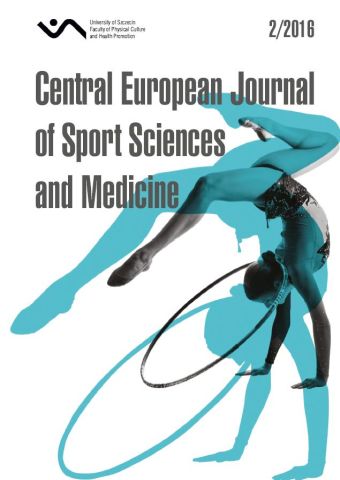
ISSN: 2300-9705
eISSN: 2353-2807
OAI
DOI: 10.18276/cej.2016.2-01




Lista wydań /
Vol. 14, No. 2/2016
Modeling the Total Energy Costs of Resistance Exercise: a Work in Progress
| Autorzy: |
Victor M.
Reis
Research Centre for Sports Sciences, Health Sciences & Human Development, University of Trás-os-Montes & Alto Douro (UTAD), Portugal Christopher B. Scott University of Southern Maine, Exercise, Health and Sport Sciences, USA |
| Słowa kluczowe: | intermittent exercise oxygen uptake weight lifting |
| Data publikacji całości: | 2016 |
| Liczba stron: | 8 (5-12) |
Abstrakt
We present an aerobic and anaerobic, exercise and recovery energy cost model of intermittent energy costs utilizing task (work, Joules) as opposed to rate (per minute) measurements. Low to moderate intensity steady state exercise energy costs are typically portrayed as the volumetric rate at which oxygen is consumed (VO2 L min–1), where a proportionate upward climbing linear relationship is profiled with an increasing power output; add to this the concept of the anaerobic threshold and energy costs increase with more intense aerobic exercise in disproportion to VO2 L min–1 measurements. As a per task function, intermittent work and recovery bouts contain a combined estimate of total costs, that is as kJ or kcal (not kJ.min-1 or kcal.min-1). Adopting this approach to describe single and multiple sets of resistance training, the model that emerges for intermittent resistance exercise portrays linearity between equivalent work and total energy costs that differs proportionately among conditions – “continuous” muscular endurance vs. Intermittent higher load strength work, moderately paced vs. slower and faster conditions, smaller vs. larger working muscle masses and failure (fatigue) vs. non-failure states. Moreover, per kcal (or kJ) of total energy costs, work (J) is more inefficient with a greater load and lower repetition number as opposed to lower resistance with an increased number of repetitions. The concept of energy costs Rusing disproportionately with increased or prolonged work does not appear to apply to resistance exercise.
Pobierz plik
Plik artykułu
Bibliografia
| 1. | Boutcher, S.H. (2011). High-intensity intermittent exercise and fat loss. J Obesity. (Article ID 868305). DOI: 10.1155/2011/868305. |
| 2. | Buitrago, S., Wirtz, N., Flenker, U., Kleinoder, H. (2014). Physiological and metabolic responses as function of the mechanical load in resistance exercise. Appl Phys Nutr Met, 39, 345–350. DOI: 10.1139/apnm-2013-0214. |
| 3. | Gorostiaga, E.M., Navarro-Amezqueta, I., Calbert, J.A.L., Sanchez-Medina, L., Cusso, R., Granados, C., Izquierdo, M. (2014). Blood ammonia and lactate as markers of muscle metabolites during leg press exercise. J Strength Cond Res, 28, 2775–2785. DOI: 10.1519/JSC.0000000000000496. |
| 4. | Hunter, G.R., Weinsier, R.L., Bamman, M.M., Larson, D.E. (1998). A role for high intensity exercise on energy balance and weight control. Int J Obesity, 22, 489–493. |
| 5. | Knuttgen, H.G. (2007). Strength training and aerobic exercise: comparison and contrast. J Strength Cond Res, 21, 973–978. DOI: 10.1519/R-505011.1. |
| 6. | Mazzetti, S., Douglass, M., Yocum, A., Harber, M. (2007). Effect of explosive versus slow contractions and exercise intensity on energy expenditure. Med Sci Sports Exer, 39, 1291–1301. |
| 7. | McBride, J.M., McCaulley, G.O., Cormie, P., Nuzzo, J.L. Cavill, M.J., Triplett, N.T. (2009). Comparison of methods to quantify volume during resistance exercise. J Strength Cond Res, 23, 106–110. |
| 8. | Scott, C.B., Nelson, E., Martin, S., Ligotti, B. (2015). Total energy costs of 3 Tabata-type calisthenic squatting routines: isometric, isotonic and jump. Eur J Human Movement, 8, 53–59. |
| 9. | Scott, C.B., Reis, V. (2014). Steady state models provide an invalid estimate of intermittent resistance-exercise energy costs. Eur J Human Movement, 33, 70–78. |
| 10. | Scott, C.B., Luchini, A., Knausenberger, A., Steitz, A. (2014). Total energy costs – aerobic and anaerobic, exercise and recovery – of five resistance exercises. Cent Euro J Sport Sci Med, 8, 53–59. |
| 11. | Scott, C.B. (2014). Combustion, respiration and intermittent exercise: a theoretical perspective on oxygen uptake and energy expenditure. Biology, 3, 255–263. DOI: 10.3390/biology3020255. |
| 12. | Scott, C.B. (2012a). Oxygen costs peak after resistance exercise sets: a rationale for the importance of recovery over exercise. J Ex Phys, 15, 1–7. |
| 13. | Scott, C.B. (2012b). The effect of time-under-tension and weight lifting cadence on aerobic, anaerobic, and recovery energy expenditures: 3 submaximal sets. Appl Phys Nutr Met, 37, 252–256. DOI: 10.1139/h11-158. |
| 14. | Scott, C.B., Earnest, C.P. (2011). Resistance exercise energy expenditure is greater with fatigue as compared to non-fatigue. J Ex Phys, 14, 1–10. |
| 15. | Scott, C.B. Leighton, B.H., Ahearn, K.J., McManus, J.J. (2011). Aerobic, anaerobic and excess postexercise oxygen consumption energy expenditure of muscular endurance and strength: 1-set of bench press to muscular failure. J Strength Cond Res, 25, 903–908. DOI: 10.1519/JSC.0b013e3181c6a128. |
| 16. | Scott, C.B., Leary, M.P., TenBraak, A.J. (2011). Energy expenditure characteristics of weight lifting: 2 sets to fatigue. Appl Phys Nutr Met, 36, 115–120. DOI: 10.1139/H10-093. |
| 17. | Scott, C.B., Croteau, A., Ravlo, T. (2009). Energy expenditure before during and after the bench press. J Strength Cond Res, 23, 611–618. DOI: 10.1519/JSC.0b013e31818c2845. |
| 18. | Tamaki, T., Uchiyama, S., Tamura, T., Nakano, S. (1994). Changes in muscle oxygenation during weight-lifting exercise. Eur J Appl Phys, 68, 465–469. |
| 19. | Vezina, J.W., Ananian, C.A.D., Campbell, K.D., Meckes, N., Ainsworth, B.E. (2014). An examination of the differences between two methods of estimating energy expenditure in resistance training activities. J Strength Cond Res, 28, 1026–1031. DOI: 10.1519/ JSC.0000000000000375. |
| 20. | Woledge, R.C. (1998). Possible effects of fatigue on muscle efficiency. Acta Phys Scand, 162, 267–273. |